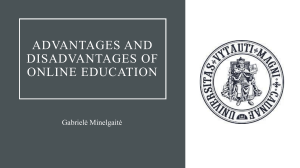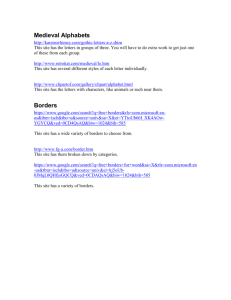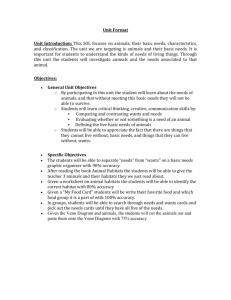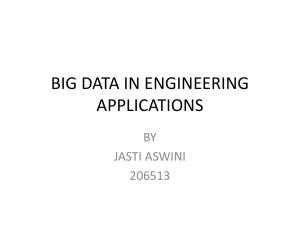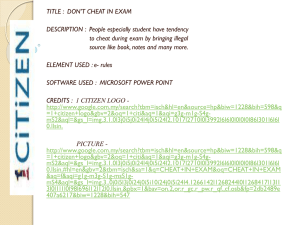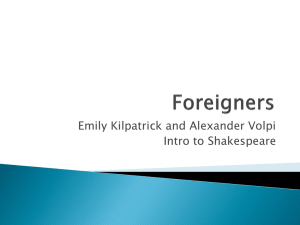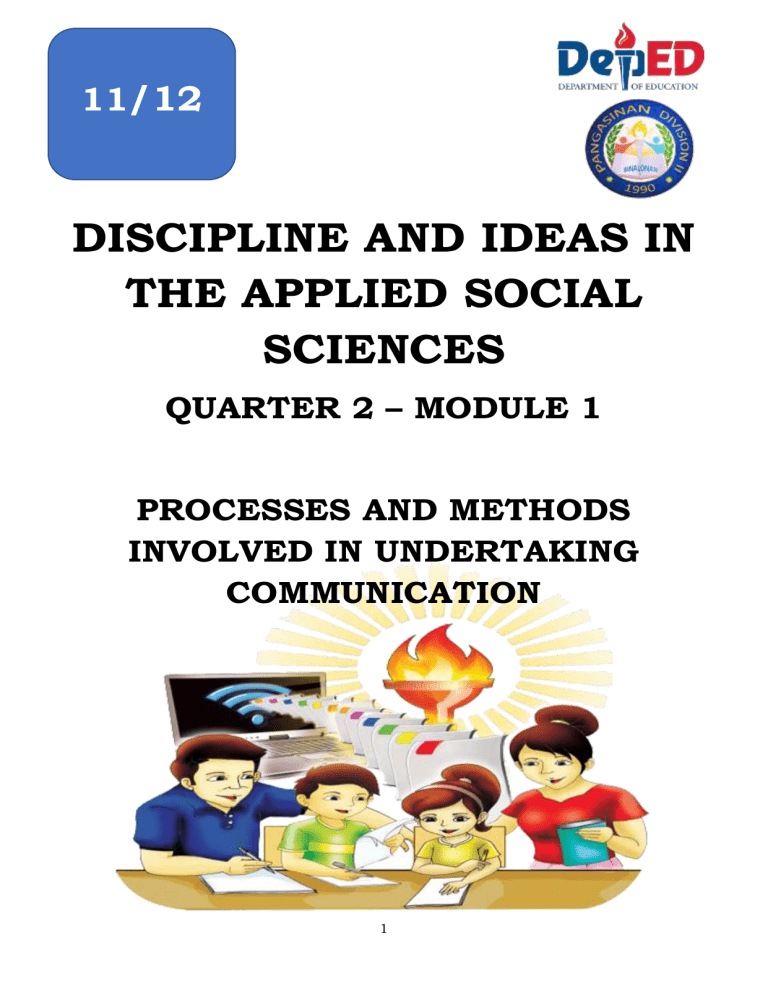
11/12 DISCIPLINE AND IDEAS IN THE APPLIED SOCIAL SCIENCES QUARTER 2 – MODULE 1 PROCESSES AND METHODS INVOLVED IN UNDERTAKING COMMUNICATION 1 INTRODUCTION (What I Need to Know) Generally speaking, the field of applied social sciences brings us to understand the unique complexity of a man’s life by looking at him situated in between the two poles of knowledge-the theoretical and the empirical poles. Thus, this subject bridges the gap between the two poles by understanding the various theories and concepts relating to his/her existence and how those shall apply to his/her everyday life which may affect his reality in this empirical world. Specifically, through this study we will be taking a deep dive into the realities taking place into a man’s life by understanding how he/she becomes affected of his/her presence in the society, his/her relationship with other people, environment, the processes taking place in his/her every situation in everyday life. This module introduces the various methods and processes involved in undertaking communication as one person relates himself/herself to another in a given context. In so doing, we will be able to see the importance of the use of various tools of communication to make us able to express our views and feelings of which may make a significant impact to our existence in the society. (MELC) Most Essential Learning Competency Illustrate the different processes and methods involved in undertaking communication. At the end of this module, you should be able to: a. determine various communication settings, tools, or methods; b. illustrate understanding of the different processes, methods and tools in communication; and c. express views learned about the settings, tools, and methods in communications. DISCUSSIONS AND ACTIVITIES (What is It) COMMUNICATION AS A DISCIPLINE Communication ss an academic discipline examines communication between people. Human interaction is regarded as the basis on which interpersonal relationships, groups and teams, organizations, communities and cultures are constructed. Furthermore, it is aimed at developing knowledge about interactional processes and communicative behavior. This discipline focuses on contacts and bonds between people, both in private and public contexts, and both faceto-face and mediated through various communication technologies. The focus of professional expertise in communication is on interpersonal relations, small group processes and organizational communication, as well as on the personal, social, contextual, and cultural factors impacting communication behavior., communication technologies, media, administration, politics, and cultural life. (https://www.jyu.fi/hytk/fi/laitokset/kivi/en/our-department/disciplines/communication) 2 COMMUNICATION SETTINGS, METHODS, PROCESSES AND TOOLS In the book of Sampa, Elias (2017) it was cited that settings of communication refer to the physical surroundings of a communication event which may be made up of the location where the communication occurs, environmental conditions, time of the day, or day of the week, as well as proximity of the communicators (Alberts, Nnakayama, & Martin 2007). He explained that what is critical about the setting is to know the audience and understand what they need to hear and how they need to receive information. The process of communication accounts for what happens between the source of the message and the recepient, the skills employed in giving and receiving information, and conveying our ideas and opinions with those around us.The methods of communication involve the verbal such as the sound, tone of voice and language , aural like listening or hearing; the non-verbal which may be through the facial expression, body language; the written such as letters, journals, memos, emails, or text messages; and the visual like the signs, symbols, illustrations or pictures. Moreover, tools in communication include all that we use in both communicating with others and interpreting the information received from others. They range from language in all its forms, from tone of voice to performing, reenacting, story telling, interviewing, television, telephone/cellphone, movie radio, photographs, digital and scoial platforms and the Internet. Moreover, Sampa, Elias (2017) pointed out five communication settings that find application in the discipline of social science. These settings include: (1) Government Setting Government is the best representation of the people, may it be public or private. It is an instrument through which the will of the people of a particular state is expressed, formulated and carried out. As such, government is particularly designated to deliver services to the people through its various arms or agencies and to make sure that public services are delivered effectively to its constituents. This being the essence of the government, Sampa (2017) explained, the purpose of communication becomes more of public to government and vice versa. The government communicates to inform the constituents about its national plans, public services, security situations, opportunities, and to give general direction to people as a nation. On this note, the government setting draws on a variety of organization methods and tools depending on the subject and intent. Finally, Sampa stated that traditionally, the government relied on mass media to disseminate public information and propaganda. With emergence of the new media, the government has also incorporated much of new technological tools. It is more common than less to find even local government units maintaining a website and communicating with their communities using social media. (2) Private Sector Setting The private sector usually refers to organizations operating businesses in the country which are also involved in providing public services in the form of creating employment opportunities to the people but are not considered as government. Basically, this sector operates of the basis of investment and profits. As such, this sector usually uses advertisements to inform the public, individuals, groups and communities about its services and goods offered in the market. On the other hand, they are getting information from the public to be able to get a pulse on what the public demands them to supply in the market. They also operate the principle of Corporate Social Responsibility as they are wanting to maintain a harmonious relationship with their public who are their clients and to foster the goal of maintaining a positive public perception. 3 (3) Civil Society Setting This sector of the society refers to the non-governmental organizations, charities, foundations, people’s organizations and other pressure groups that exist to advocate the causes of social justice on behalf of the marginalized sectors, disenfranchised, and the minorities or the underserved. These groups usually come to complement the government and the private sector as they do not operate businesses for profits but offer services to the public which is a function that belongs to the government. In many circumstances they engage as well in business operations in order to raise funds that will be used in return to respond to the needs or problems affecting the represented sector or issue. Hence, communication in this setting is operated on the basis of the mission and action chosen by the civil society. They can draw almost all forms of communication tools available. They often use new and social media to bring their cause to a wide audience possible and effectively. (4) School Setting Schools are both educational and social institutions. Communication in this setting operates on the basis of providing educational services to the public and engage communities in setting up the agenda for educational goals and means. Being a formal institution, communication taking place in the school setting is made formal and academic. However, with the emergence of the new media, communication in schools has transformed to the next level to include new forms of communities cutting across schools to create community of learners that are not just confined in the physical environment of the schools. With the presence of technology more exchange of information are made possible among students through virtual and other digital platforms where students can learn together and accomplish given tasks without physically coming together. (5) Community Setting The community is where all sectors interact like the government, businesses, civil society, and just about all individuals and groups. In a broad sense, communication with communities is intended to favor one directional pattern of mass media. The exchange of information between and among the sectors of the community as well as the government are taking place for purposes of keeping them informed of the most important things that affect the community in general and the individuals or groups in particular. Thus, various communication tools and methods are appropriately drawn to achieve community setting communication goals. On this level, a face-toface- communication, tarpaulins as well as graffiti are very common. ACTIVITY 1: SHOW ME THE WAY! Directions: Read each situation and answer the question guided by the diagram below. Write your answers in your answer sheet. SITUATION NO. 1 Scenario: Pedro is applying for a job. He has prepared his curriculum vitae and portfolio to make sure that he has all that is needed for the interview that is scheduled the following day. During the interview, he was asked the following questions “Should you be hired? How will you contribute to this company?” Pedro replied “ I will do all my best to do my duties as assigned without complaints. I will give my best efforts in all tasks related to my work.” 4 What is the message? Who is the Receiver? What channel of communication is used? Who is the Sender? What is the Feedback? https://www.google.com/search?q=INTERVIEW+CARTOON&tbm=isch&ved=2ahUKEwi9tKP3ysrtAhVPapQKHeFeARcQ2cCegQIABAA&oq=INTERVIEW+CARTOON&gs_lcp=CgNpbWcQAzICCAAyAggAMgIIADICCAAyAggAMgIIADICCAAyAggAMgIIADICCAA6BAgAEENQvrgGWIfIBmDQ1AZoAHAAeACAAZ 4BiAHFBpIBAzUuM5gBAKABAaoBC2d3cy13aXotaW1nwAEB&sclient=img&ei=79bVX_2AIs_U0QThvYW4AQ&bih=578&biw=1280#imgrc=4odUtDJ1S6vO7M Guide Question: What setting of communication is reflected in the given situation?_____________________________ SITUATION NO. 2 Scenario: Recently many people in Manila protested against the implementation of the Enhanced Community Quarantine rules. During the protest, the people reported cases of abuse of power and authority of some policemen who were considered as frontlines during the ECQ. During the Press briefing, the PNP’s spokeperson answered by saying “ the policemen involved are now under investigation” What is the message? What channel of communication is used? Who is the Receiver? Who is the Sender? What is the Feedback? https://www.google.com/search?q=PROTEST+CARTOON&tbm=isch&ved=2ahUKEwiRr5esy8rtAhXBBaYKHRwFCt8Q2cCegQIABAA&oq=PROTEST+CARTOON&gs_lcp=CgNpbWcQAzICCAAyAggAMgIIADICCAAyAggAMgIIADICCAAyAggAMgIIADICCAA6BggAEAcQHjoECAAQQzoHCAAQsQMQQzoFCAA QsQNQ1pQEWJavBGDZuARoAHAAeACAAX2IAcgKkgEDNS44mAEAoAEBqgELZ3dzLXdpei1pbWfAAQE&sclient=img&ei=XtfVX5GIH8GLmAWciqj4DQ&bih=578&biw=1280#imgrc= -o4wmQpkLSbsVM Guide Question: What method/s of communication was used ?__________________________________________________ SITUATION NO. 3 Scenario: Because of the pandemic, many private and public schools were caught unprepared to the new normal. In order to address this problem, the Department of Education has developed a Learning Continuity Plan which includes the avoidance of face-to-face interaction between teachers and among students, conduct of online classes, adoption of flexible learning modalities in schools. The learning Continuity Plan was reiterated through a Department Memorandum and was presented to the media for the information of the public. The parents gave opposing views on the opening of classes on August 24, 2020. 5 What is the message? What channel of communication is used? Who is the Receiver? Who is the Sender? What is the Feedback? https://www.google.com/search?q=CARTOON+STOCK+PRESS+RELEASE&tbm=isch&ved=2ahUKEwid2ZXWzcrtAhUK5pQKHWodAwAQ2cCegQIABAA&oq=CARTOON+STOCK+PRESS+RELEASE&gs_lcp=CgNpbWcQAzoCCAA6BAgAEEM6BggAEAUQHjoGCAAQCBAeUIEA1imrwNg0rEDaAFwAHgAgAHRAYgBwQySAQYxMC40LjGYAQCgAQGqAQtnd3Mtd2l6LWltZ8ABAQ&sclient=img&ei=z9nVX921GorM0wTqugw&bih=578&biw=1280#imgrc=h8qo pOhOBJnCuM Guide Question: What tool of communication was applied? _________________________________________________ SITUATION NO. 4 Scenario: The outbreak of the COVID 19 pandemic was not foreseen by many of our world leaders as well as the peoples of the world. The community then, was just informed through the news in the television that the virus was spreading too fast. Through the media, the people were informed as to what should be done to avoid the virus. The public, however, expressed their frustration to the leaders of the Department of Health on how they managed to control the situation. What is the message? What channel of communication is used? Who is the Receiver? Who is the Sender? What is the Feedback? https://www.google.com/search?q=CARTOON+STOCK+PRESS+RELEASE&tbm=isch&ved=2ahUKEwid2ZXWzcrtAhUK5pQKHWodAwAQ2cCegQIABAA&oq=CARTOON+STOCK+PRESS+RELEASE&gs_lcp=CgNpbWcQAzoCCAA6BAgAEEM6BggAEAUQHjoGCAAQCBAeUIEA1imrwNg0rEDaAFwAHgAgAHRAYgBwQySAQYxMC40LjGYAQCgAQGqAQtnd3Mtd2l6LWltZ8ABAQ&sclient=img&ei=z9nVX921GorM0wTqugw&bih=578&biw=1280#imgrc=h8qo pOhOBJnCuM Guide Question: Illustrate by way of a process diagram the communication processes involved in the given situation _______________________________________________________________________________________ 6 SITUATION NO. 5 Scenario: Due to the COVID 19 pandemic, President Rodrigo R. Duterte put the entire Luzon area under Enhanced Community Quarantine. As such, everybody was advised to stay at home and that only one member of the family household would be allowed to go out to buy essential needs like food and medicine. This situation has brought many families to lose the opportunity to earn, thus, many suffered hunger. Generous individuals and organizations offered help to alleviate the situation through different forms of aid in communities. The Local Government officials gratefully responded and assisted the relief operations. What is the message? What channel of communication is used? __ Who is the Receiver? Who is the Sender? What is the Feedback? https://www.google.com/search?q=CC123067&tbm=isch&ved=2ahUKEwjroY2f0MrtAhVIYpQKHcz4AOIQ2cCegQIABAA&oq=CC123067&gs_lcp=CgNpbWcQAzoCCAA6BAgAEEM6CAgAELEDEIMBOgUIABCxAzoHCAAQsQMQQzoGCAAQBRAeOgQIABAYUIbKB1jP9AlgiPwJaABwAHgEgAG OAYgBhQuSAQM0LjmYAQCgAQGqAQtnd3Mtd2l6LWltZ7ABAMABAQ&sclient=img&ei=gdzVX6vdD8jE0QTM8YOQDg&bih=578&biw=1280#imgrc=WhnJBKSjbvdYSM Guide Question: Answer the questions in the diagram._________________________________________________________ Activity 2: WORD SEARCH Directions: Find eight (8) words related to the tools and methods used in communication from the grid. Write your answer in your answer sheet. 7 Activity 3: MIND STRETCH! Directions: Below are statements related to the settings, methods, and tools used in communication. Write YES if you agree and NO if you disagree. Justify your answer. Write your answers in your answer sheet. (5 points each) Example: HUMSS is an Academic Track in the Senior High School which focuses on individuals and society as its object of study. YES. Because HUMSS as a discipline deals with the character and behavior of man in a given society. Example is on the function of Social Work, where it deals with connecting the people and the resources for the betterment of the society in general based on their particular needs. 1. Communication is very important in any situation or setting. _______, _______________________________________________________________________________________________ 2. Social Media is “ IN “ while radio is “ OUT “ nowadays. _______, _______________________________________________________________________________________________ 3. Virtual Classroom is necessary in this time of pandemic. _______, _______________________________________________________________________________________________ 4. Understanding among people will only be achieved if there is communication.________, _______________________________________________________________________________________________ 5. Various settings of communication require a particular communication tool. _______, _______________________________________________________________________________________________ RUBRIC: Criteria 3 2 1 Reasoning The justifications are highly insightful and logically presented to address the issue The justifications are moderately insightful and logically presented to address the issue The justifications are lowly insightful and logically presented to address the issue The answer persuasive. The answer persuasive The answer is lowly persuasive Persuasiveness And Brevity is highly is moderately ASSESSMENT I. Directions: Choose the correct answer to each of the questions below. Write the letter of your choice in your answer sheet. _____1.This is where all sectors interact like the government, businesses, civil society, and just about all individuals and groups and is intended to favor one directional pattern of mass media. a. Civil society b. Community c. Government d. Private Sector _____2. Relies on mass media to disseminate public information and propaganda. a. Civil society b. Community c. Government d. Private sector _____3. Operates on the basis of providing educational services to the public and engage communities in setting up the agenda for educational goals and means a. Civil society b. Education c. Government d. Private sector _____4. Communication in this setting is based on the mission and action chosen by the civil society. a. Civil society b. Community c. Government d. Private sector 8 _____5. Develops knowledge about interactional processes and communicative behavior a. Communication setting c. Tools in communication b. Communication d. Tools in communication II-A Directions: Match the terms in Column B with its description in Column A. Write the correct letter of your choice in your answer sheet. COLUMN A 1. Involves the verbal, aural, non-verbal, written and the visual scheme in communication. 2. Includes all that we use in both communicating with others and interpreting the information received from others. 3. Accounts for what happens between the source of the message and the recipient, the skills employed in giving and receiving information, and conveying our ideas and opinions with those around us. 4. The physical surrounding of a communication event which may be made up of the location where the communication occurs, environmental conditions, time of the day, or day of the week, as well as proximity of the communicators. 5.Which element of communication is best described by the place where the communication is taking place? COLUMN B A. Communication method B. Communication process C. Communication setting D. Communication tools E. Communication context F. Communication skills II-B Directions: Identify what is described in each statement below. Choose your answer from the box and write your answer in your answer sheet. Message Feedback Ethics Non-verbal Communication ______ 1. Element of communication that is supported by the act and react mechanism. ______2. The idea being transmitted by the sender to the listener. ______3. Dual or two-way process of transmitting messages from one person to another. ______4. Characteristic of verbal communication that makes use of words in consideration of the gender, roles, ethnicity or status of the person talking to. ______5. Uses behavior to convey and represent meanings. III. Directions: Explain each statement below. ( 5 points each ) 1. Difference between communication processes and settings. _______________________________________________________________________________________________ 2. Similarities of communication tools from communication methods. _______________________________________________________________________________________________ 3. Importance of communication in the field of applied social sciences. _______________________________________________________________________________________________ 9 Rubric: Criteria Content Reflective Thoughts Grammar and Spelling 5 The explanation demonstrates high level of understanding of the lesson The reflective thought is in-depth The explanation is totally free from grammatical error and misspelled words 4 The explanation demonstrates average level of understanding of the lesson The reflective thought is average The explanation contains minor grammatical error and misspelled words 3 The explanation demonstrates low level of understanding of the lesson The reflective thought is shallow The explanation contains major grammatical error and misspelled words ANSWER KEY FOR ACTIVITIES Situation #5 1. Civil Society Setting 2. Verbal and Non-verbal 3. Face-to-Face 4. Answer may vary ACTIVITY 2 Situation #4 1. Government Setting 2. Verbal 3. Mass Media (TV,Radio) 4. Answer may vary Situation #3 1. Educational Setting 2. Written 3. Mass Media (TV,Radio) 4. Answer may vary Situation #2 1. Community Setting 2. Aural 3. Mass Media (TV,Radio) 4. Answer may vary ACTIVITY 1 Situation #1 1 Private Sector Setting 2. Verbal 3. Face-to-Face 4. Answer may vary 1. 2. 3. 4. 5. YES, justification may vary NO, justification may vary YES, justification may vary YES, justification may vary YES, justification may vary ACTIVITY 3 REFERENCES Elias M. Sampa (2017) Discipline and Ideas in the Applied Social Sciences, Rex Book Store, Inc.Quezon City, Philippines University of Jyväskylä, Finland (10,22 2020), Communication, an academic discipline: retrieved from https://www.jyu.fi/hytk/fi/laitokset/kivi/en/ourdepartment/disciplines/communication IMAGES https://www.google.com/search?q=pre+assessment&sxsrf=ALeKk01OxObUpOvGKOfjcn7U5Sh3X3NPfQ:1603856099081&source=lnms&tbm=isch&sa=X&ved=2ahUKEwiEt rnIrdbsAhWUxIsBHZKzAKQQ_AUoAXoECA8QAw&biw=1280&bih=578#imgrc=xFKI_yWL2zKzFM https://www.google.com/search?q=INTRODUCTIONICON&tbm=isch&ved=2ahUKEwji2LvJrdbsAhVB15QKHUSeBCQQ2cCegQIABAA&oq=INTRODUCTIONICON&gs_lcp=CgNpbWcQAzICCAA6BAgAEEM6BQgAELEDOgcIABCxAxBDOgYIABAKEBhQxIU_WN OsP2D2sD9oAHAAeACAAdYBiAHC5IBBjEyLjMuMZgBAKABAaoBC2d3cy13aXotaW1nwAEB&sclient=img&ei=5eaYX6LSDMGu0wTEvJKgAg&bih=578&biw=1280#imgrc =2jF74RibAOy4pM https://www.google.com/search?q=competency&tbm=isch&ved=2ahUKEwiBpb65sdbsAhVQxWEKHb0_BikQ2cCegQIABAA&oq=competency&gs_lcp=CgNpbWcQAzIFCAAQsQMyAggAMgIIADICCAAyAggAMgIIADICCAAyAggAMgIIADICCAA6BAgjE 10 CdQ04YpWKaWKWCTnCloAHAAeACAAXCIAbQGkgEDOS4xmAEAoAEBqgELZ3dzLXdpei1pbWfAAQE&sclient=img&ei=9eqYX8HWGtC KhwO9_5jIAg&bih=578&biw=1280 https://www.google.com/search?q=objective+icon&tbm=isch&ved=2ahUKEwiJwaD8s9bsAhWWB94KHXlBCD4Q2cCegQIABAA&oq=objective+icon&gs_lcp=CgNpbWcQAzICCAAyAggAMgIIADICCAAyAggAMgIIADICCAAyAggAMgIIADICCAA6BAgAEEM 6BQgAELEDOgcIABCxAxBDOggIABCxAxCDAVCKxRYlpwVYPefFWgAcAB4AIABiQGIAb4JkgEEMTIuMpgBAKABAaoBC2d3cy13aXotaW1nwAEB&sclient=img&ei=mu2YX4mMFJaPAb5gqHwAw&bih=578&biw=1280#imgrc=3YEO4zxkabeHsM https://www.google.com/search?q=concepts+icon&tbm=isch&ved=2ahUKEwi24oqjtdbsAhVOZd4KHaD7AUwQ2cCegQIABAA&oq=concepts+icon&gs_lcp=CgNpbWcQAzICCAAyAggAMgYIABAFEB4yBggAEAUQHjIGCAAQBRAeMgYIABAFEB4yBggAE AgQHjIGCAAQCBAeMgQIABAYOgQIIxAnOgQIABBDOgcIABCxAxBDOgUIABCxA1DgjRVYgKkVYIasFWgAcAB4AIABfYgBigmSAQQxMS 4ymAEAoAEBqgELZ3dzLXdpei1pbWfAAQE&sclient=img&ei=-O6YX7aGDM7KQag94fgBA&bih=578&biw=1280#imgrc=wXHuQpEca8TU6M https://www.google.com/search?q=post+test+icon&tbm=isch&ved=2ahUKEwj9v5Sxt9bsAhWLApQKHZ_aDdcQ2cCegQIABAA&oq=post+test+icon&gs_lcp=CgNpbWcQAzICCAAyBAgAEB4yBggAEAUQHjoECAAQQzoFCAAQsQM6BwgAELEDEEM6Bgg AEAgQHlDE0CZY2PAmYJr1JmgBcAB4AIABlwGIAaMKkgEEMTMuMpgBAKABAaoBC2d3cy13aXotaW1nwAEB&sclient=img&ei=LvGY X_3wI4uF0ASftbe4DQ&bih=578&biw=1280#imgrc=FtxuHASGutfHkM https://www.google.com/search?q=OBJECTIVES&source=lnms&tbm=isch&sa=X&ved=2ahUKEwj_0bHgtcrtAhWGGKYKHaRcDsIQ_A UoAXoECBAQAw&biw=1280&bih=578&dpr=1.5#imgrc=E_FLJHz_jVCoeM DIVISION QUALITY ASSURANCE MANAGEMENT TEAM IN HUMSS WRITER: CHRISTOPHER A. CRUZ, PhD. VALIDATORS: DR. MARILEX A. TERCIAS DR. EUGENE M. TORALBA DR. ALBERTO O. RABANG DR. VIRGINIA B. FREGILLANA JEANNEROSE M. ACOSTA ZOSIMA IRENE H. FERNANDEZ MA. JOCELYN J. SOTONG DANILO T. SIBLAG VICTOR B. ABAN JAMELIE M. CRISPINO CONSULTANTS: DR. DANILO C. SISON DR. TEODORA V. NABOR DR. CORNELIO R. AQUINO DR. JEROME S. PARAS DR. MAYBELENE C. BAUTISTA 11 12 II.A MATCHING TYPE 1. A 2. D 3. B 4. C 5. E II.B I. MULTIPLE CHOICE 1. Feedback 1. B 5. Non-verbal 3. Answer may vary 4. A 4. Ethics 2. Answer may vary 3. B 3. Communication 1. Answer may vary 2. Message III. ESSAY 2. C 5.B ANSWER KEY FOR ASSESSMENT

